This Easy Baked Easter Cheesecake is creamy, dreamy goodness that melts in your mouth with every bite. With its cheerful colors, velvety texture, and irresistible flavor, it’s sure to be a hit at your Easter celebration.
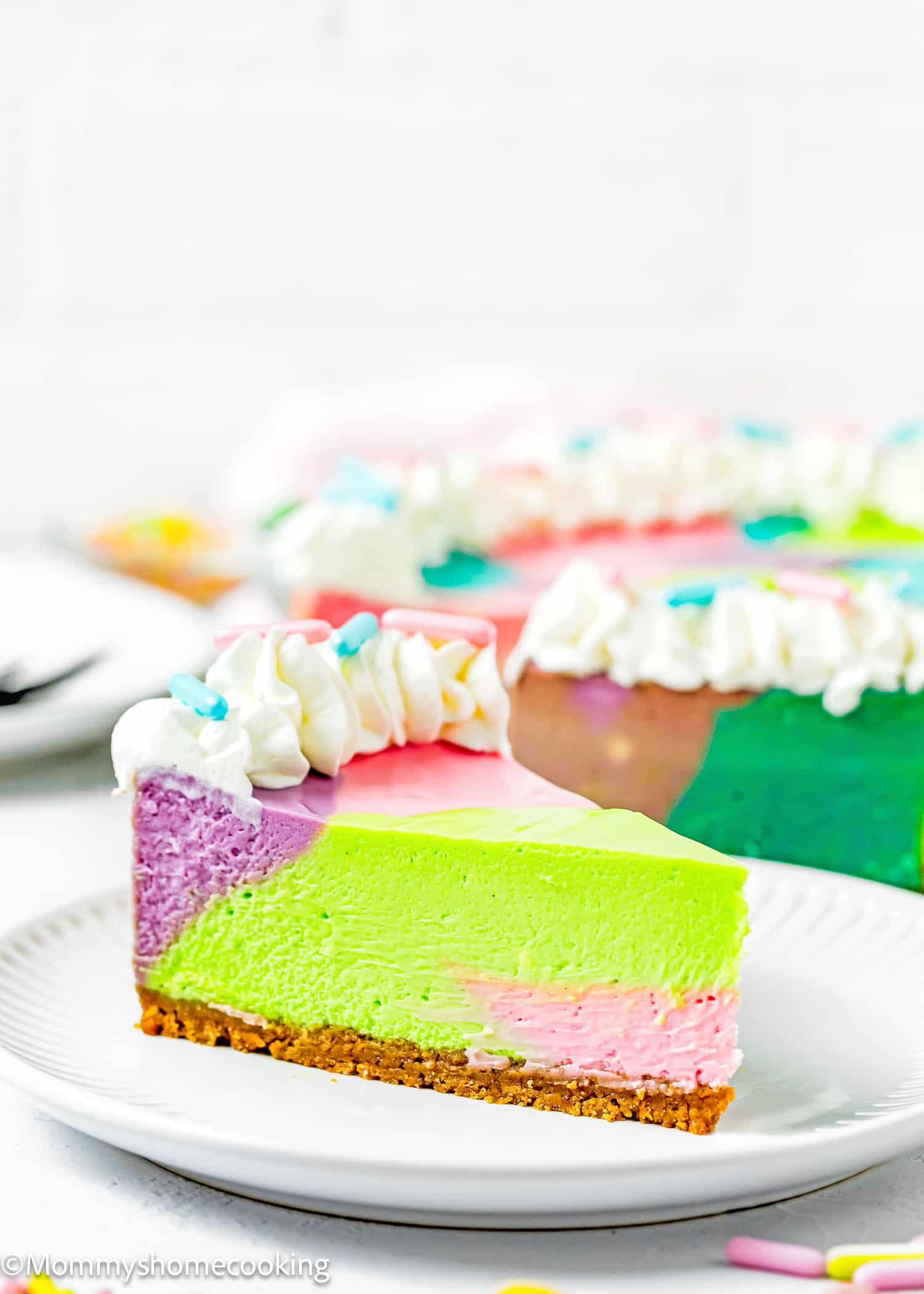
Springtime Bliss: Easy Easter Cheesecake!
Spring is in the air, and what better way to celebrate than with a delightful dessert that embodies the season’s essence? My Easy Baked Easter Cheesecake is the perfect treat to usher in the warmer weather and all its joys.
Bursting with flavor and adorned with pastel hues, this cheesecake is a true showstopper that will impress your friends and family. Plus, it’s egg-free, making it suitable for those with food allergies and dietary restrictions.
Now, let’s talk about cheesecake preferences. Don’t get me wrong – I adore a good ol’ no-bake cheesecake as much as the next person. There’s something undeniably delightful about its creamy texture and effortless preparation. But let me tell you, nothing quite beats the luxurious indulgence of a perfectly baked cheesecake. So, while I’ll never say no to a slice of no-bake cheesecake when it comes to Easter celebrations, it’s all about that silky, decadent baked goodness. Plus, baked cheesecake is my family’s favorite dessert, hands-down!
If you are on the lookout for a no-bake recipe, check out my No-Bake Easter Cheesecake Recipe.
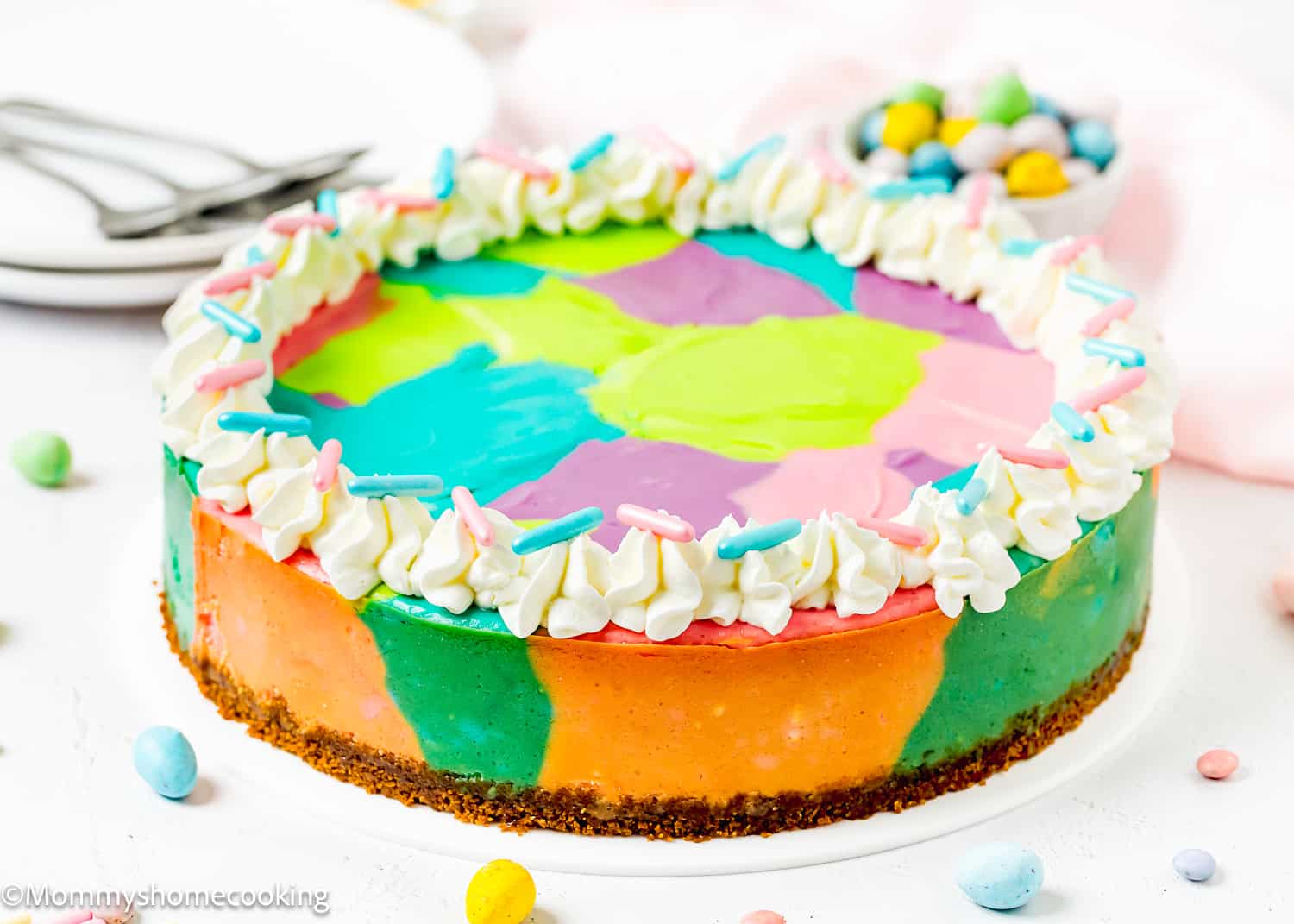
What To Love About This Recipe
- Easy to make: This cheesecake is a breeze to whip up. With simple instructions, there’s no need to stress in the kitchen—just mix, pour, and bake!
- Simple Ingredients: The ingredients in this recipe are pantry staples that you likely already have on hand. No need for any fancy or hard-to-find items.
- Showstopper dessert: This cheesecake isn’t just delicious – it’s also a sight to behold! Adorned with vibrant pastel colors, it’s sure to steal the show at your Easter celebration. Plus, the cute factor is off the charts!
- Out-Of-This-World-Texture: Bite into a slice of this cheesecake, and you’ll be met with a velvety smooth texture that melts in your mouth. It’s like indulging in a creamy cloud of bliss!
- The Perfect make-ahead dessert to share: Hosting a gathering can be stressful, but dessert doesn’t have to be. With this cheesecake, you can do all the prep work ahead of time and chill until it’s time to serve. That means more time mingling with your guests and less stress in the kitchen. Sounds like a win-win to me!
Ingredients You’ll Need, Substitutions & Notes
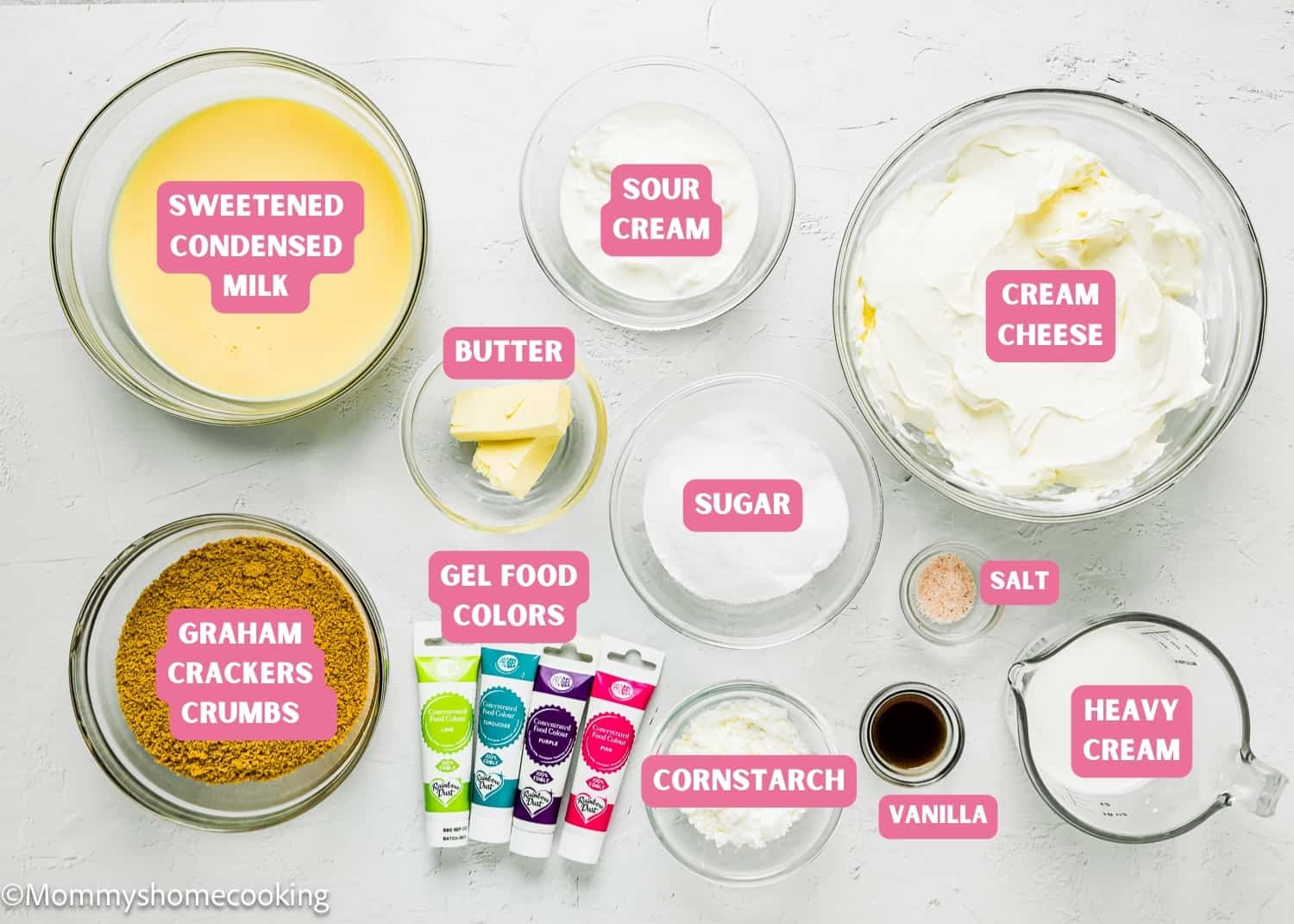
Please check the recipe card at the bottom of the post for exact quantities and detailed instructions (scroll down).
For the Crust:
- Graham cracker crumbs: These form the base of the crust, providing a deliciously crunchy texture.
- Butter: Melted butter binds the crumbs together, creating a sturdy crust that holds up well against the creamy filling.
- Granulated sugar: Just a touch of sugar adds a hint of sweetness to the crust.
For the Filling:
- Cornstarch: Helps to thicken the filling and create a smooth texture.
- Granulated sugar: Sweetens the filling without overpowering the other flavors.
- Cream cheese: The star ingredient of any cheesecake, cream cheese provides richness and creaminess. Make sure you use the full-fat version that comes in blocks.
- Sour cream: Adds a tangy kick and helps to achieve that signature cheesecake flavor. Use a full-fat version for better texture.
- Sweetened condensed milk: Provides sweetness and richness to the filling, ensuring a luscious texture. Use full-fat version.
- Lemon juice: Adds a bright, citrusy flavor that balances the richness of the cheesecake.
- Pure vanilla extract: Enhances the overall flavor profile with its warm and aromatic notes. Reach for pure vanilla instead of imitation for optimal flavor. Even better, try homemade vanilla extract! If you are looking for non-alcoholic vanilla flavoring, I recommend Simply Organic Vanilla Flavoring.
- Heavy cream: Whipped to soft peaks and folded into the filling, heavy cream adds lightness and airy texture. Make sure it has at least 35% of fat content.
- Gel food colors: Use your favorite pastel shades to give your cheesecake a festive Easter vibe. I used pink, green, purple, and blue for a colorful twist! The amount of food coloring you use will depend on its concentration. I recommend using gel or paste food colors since they are highly concentrated, and you’ll end up using less.
Process Overview: How To Make Easy Baked Easter Cheesecake Step-by-Step
Please check the recipe card at the bottom of the post for exact quantities and detailed instructions (scroll down).
Step 1 – Prepare the Crust
In a medium mixing bowl, combine graham crumbs, butter, and sugar with a fork until evenly moistened.
Pour the crumbs mixture into the springform pan and press the crumbs down into the base (and up the sides if desired). Tip: Press down the crumbs evenly at the bottom of a measuring cup or glass.
Bake crust at 350º F (180º C) until set and fragrant, about 8 to 10 minutes. Remove to a wire rack to cool for at least 30 minutes before filling. Note: If you are short of time you can refrigerate the unbaked crust while you make the filling. I have done it both ways, and it works fine. Baking the crust ensures that you have a crispier bottom, though.
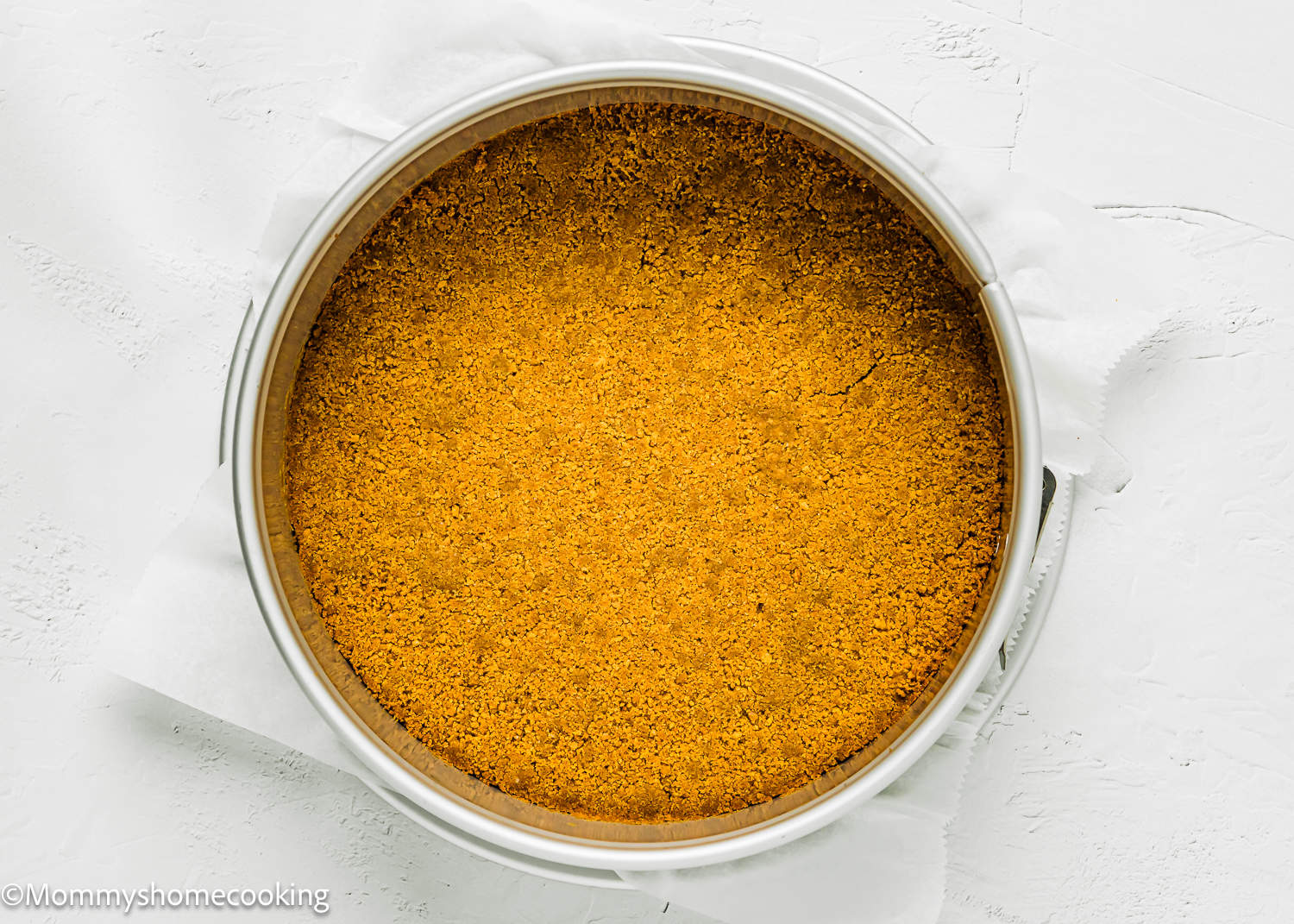
Step 2 – Prepare The Cheesecake Batter
Mix cornstarch and sugar in a small bowl. Set aside.
Place the cream cheese and sour cream in a large bowl. Beat on low speed for 2-3 minutes until smooth and free of lumps. Add the sugar mixture and continue mixing until incorporated. Gradually add sweetened condensed milk and beat until creamy, for 1-2 minutes. Add lemon juice and vanilla extract; beat until well incorporated. Add whipped heavy cream and increase the speed to medium. Beat for 3 – 4 minutes. Set aside.
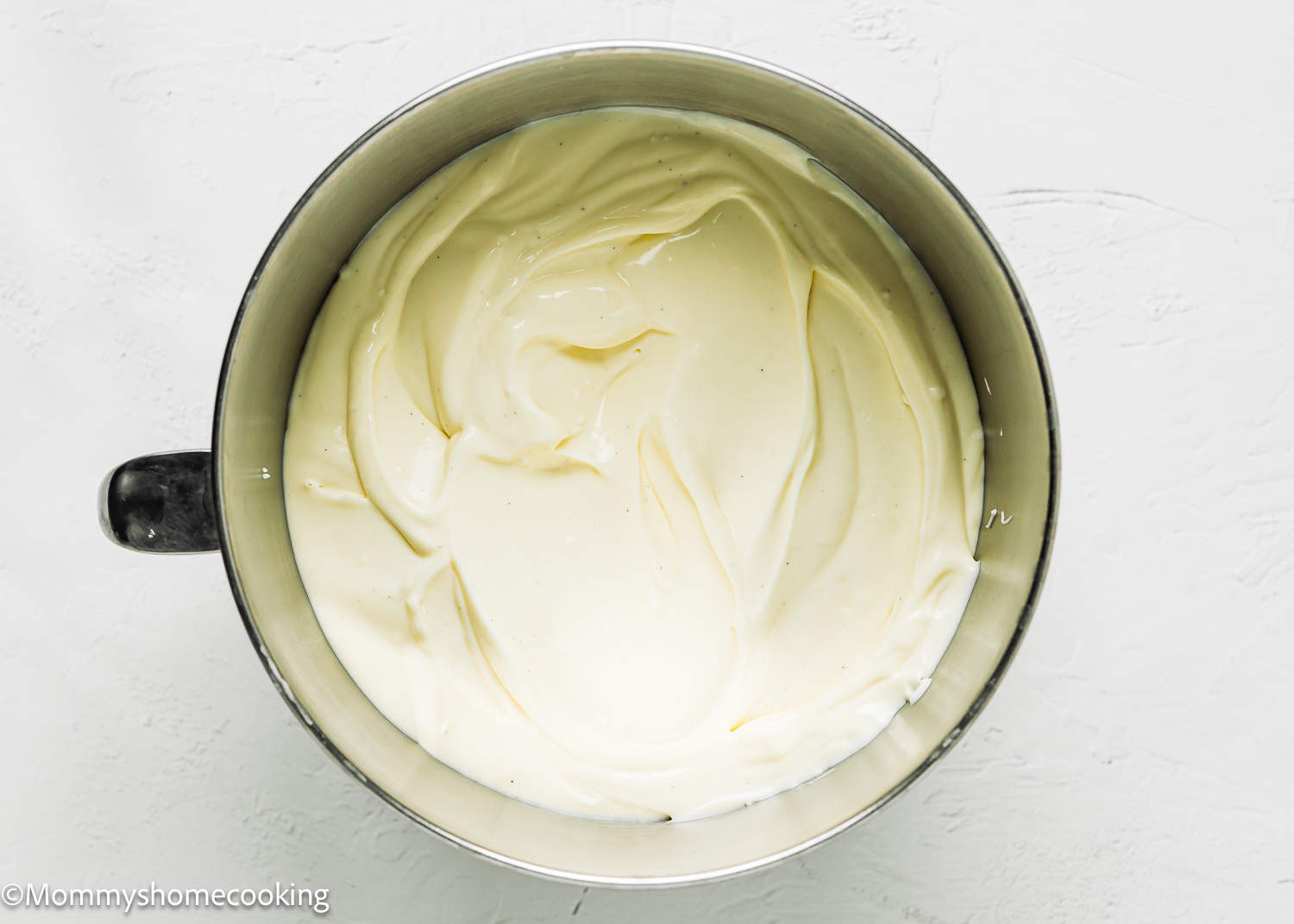
Step 3 – Prepare the Pan for The Water Bath
Place the cheesecake pan on two large pieces of heavy-duty aluminum foil and fold up the sides around it (this is to keep the water from seeping into the cheesecake).
💡 Pro Tip: After many years of cheesecake making, I have concluded that most springform pans leak. To avoid water leaks, I like to wrap the springform pan with a double layer of heavy-duty foil and then a slow cooker liner. To do so, I place the springform pan in the middle of the slow cooker liner, grab all that excess baggage, wind it up, and tie the end with a knot, covering the underside and coming all the way to the top.
Step 4 – Divide and Color the Batter
- Divide the batter into 4 equal portions, about 2 cups (480 g) of batter each.
- Color each portion with the gel food colors of your preference. I used pink, green, purple, and blue.
- Add spoonfuls of colored batter to the baking pan. I used a ¼ cup ice cream spoon. To get a colorful pattern, don’t put the same colors too close together; instead, alternate the colors throughout the pan.
- When all the batter is in the pan, gently tap 3 – 4 times to remove any air bubbles and combine the portions.
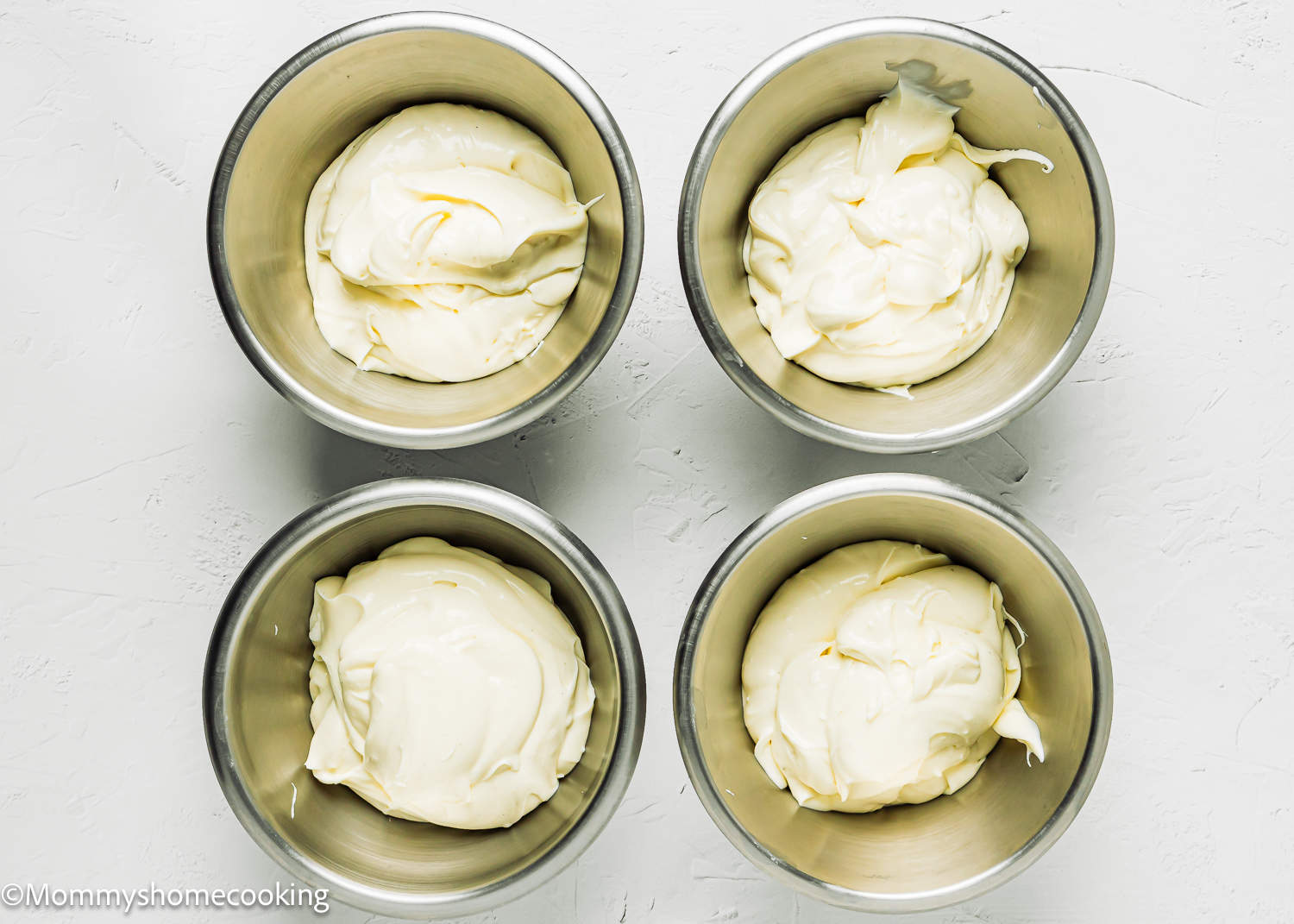
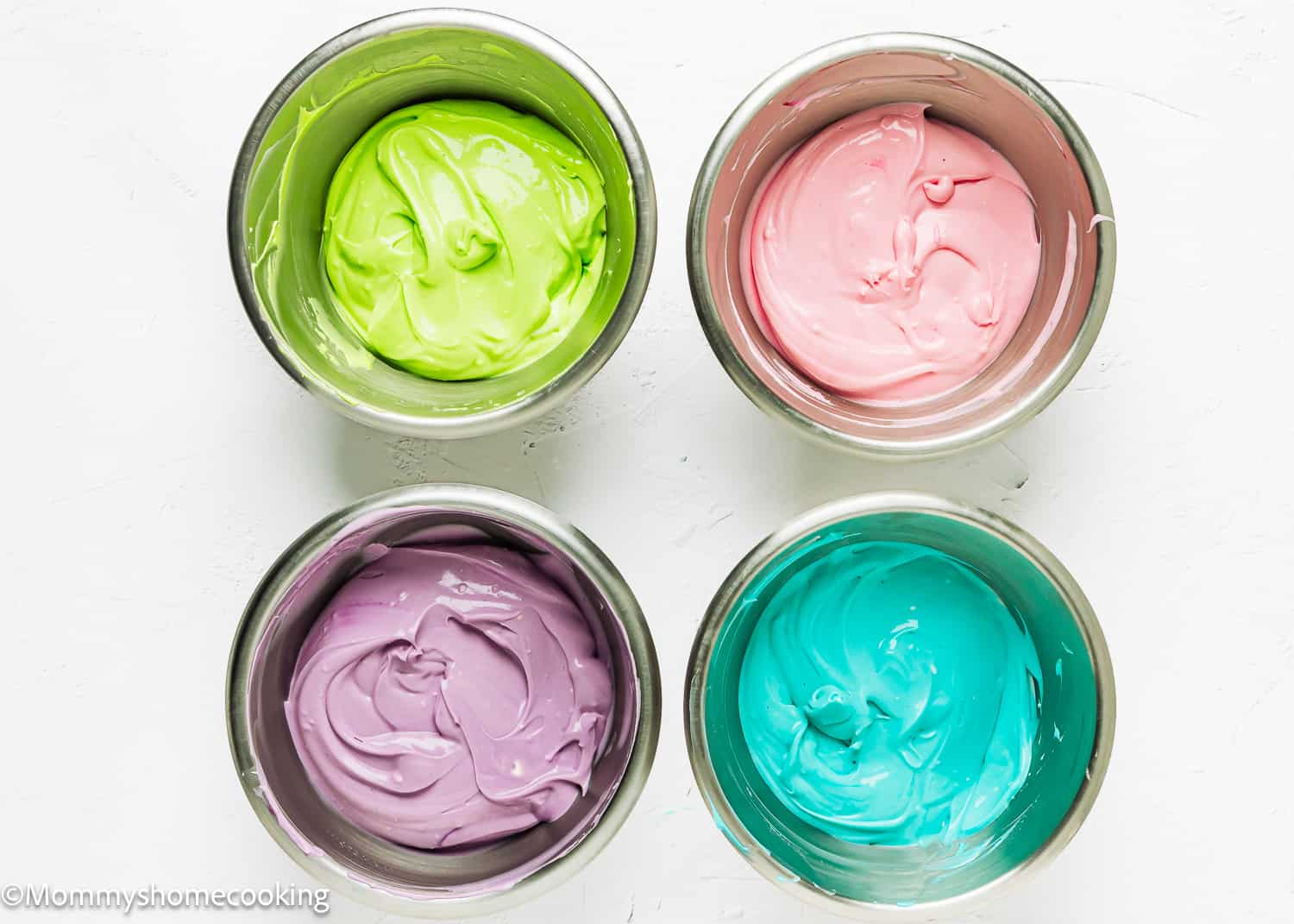
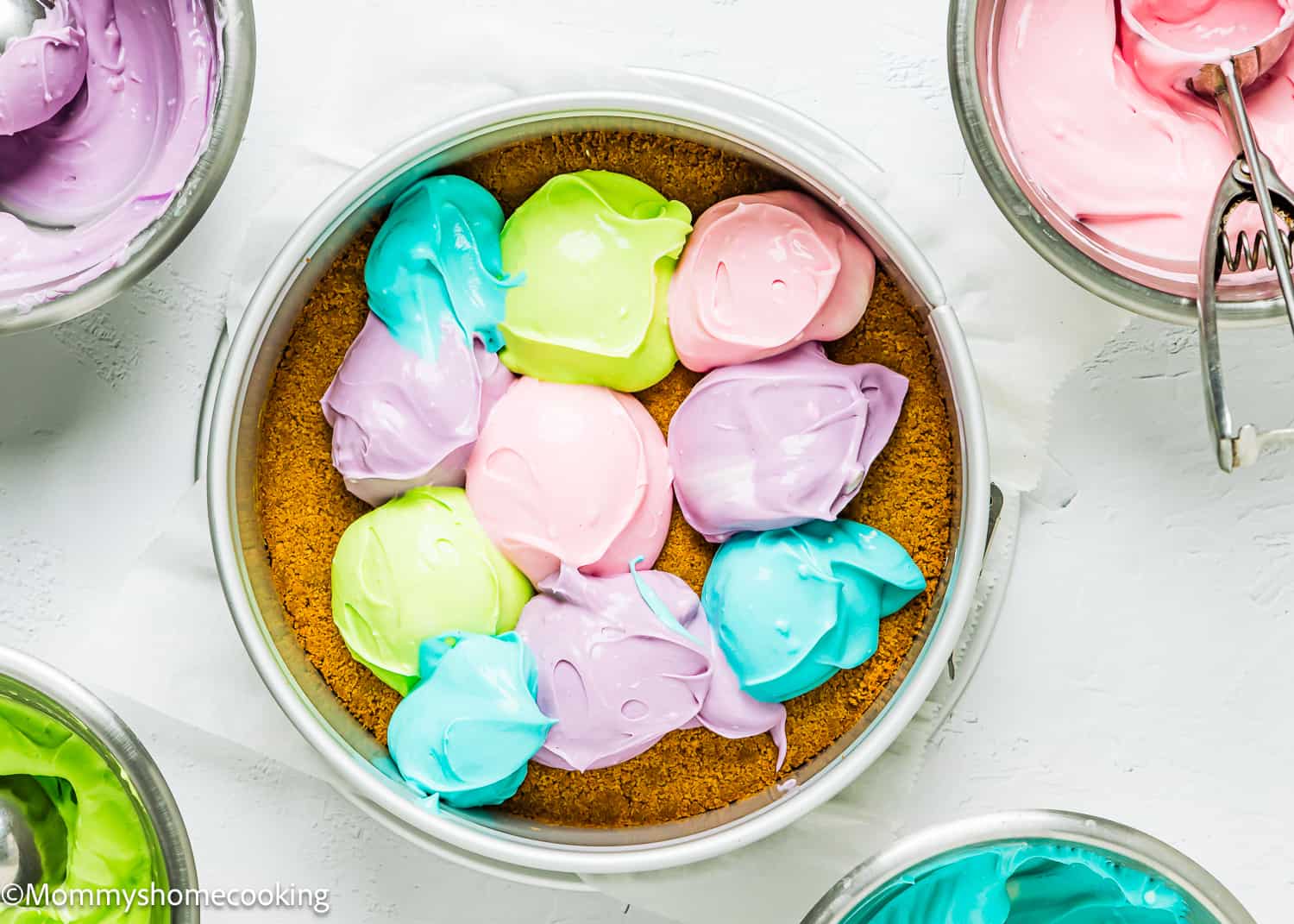
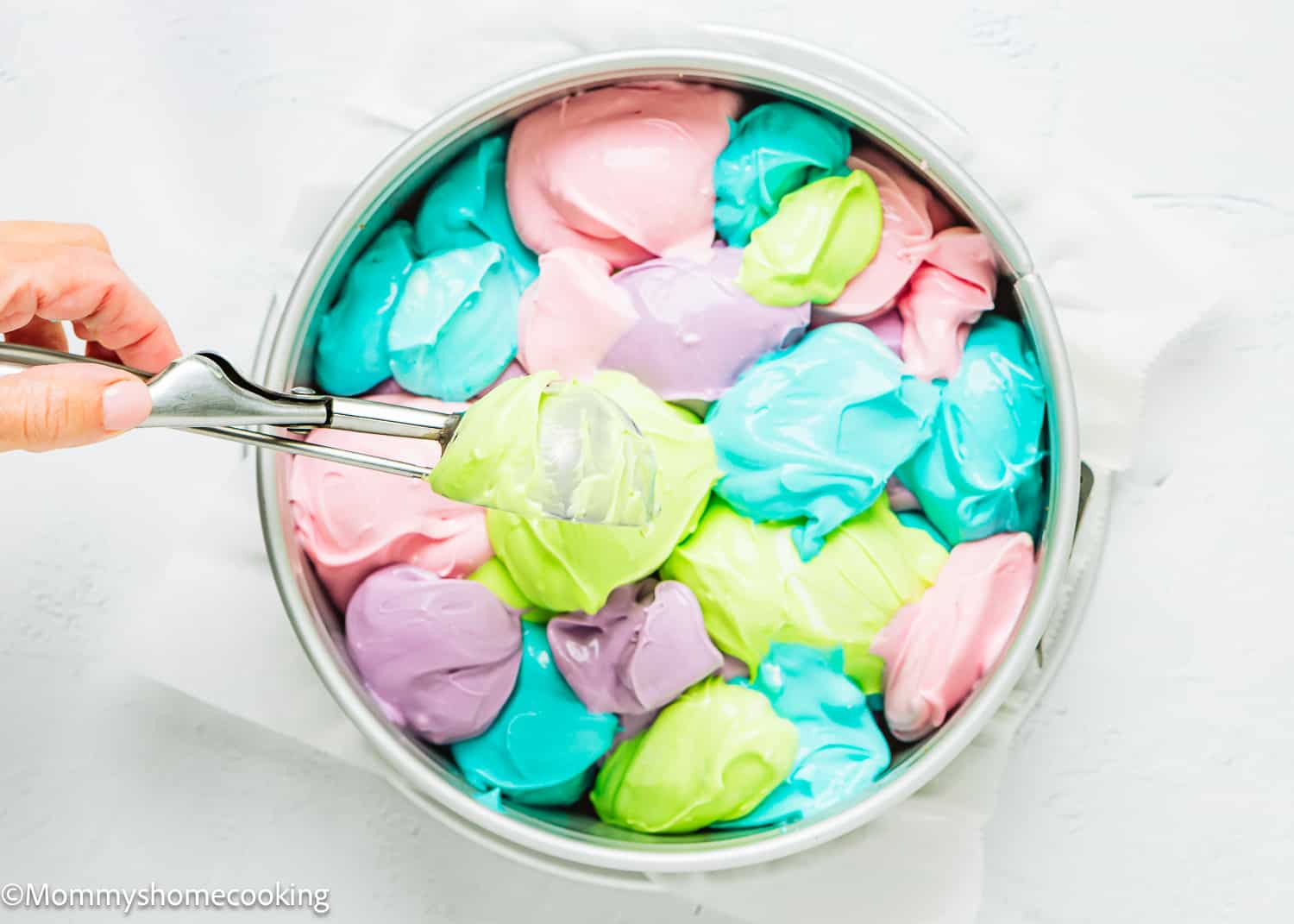
Step 5 – Water Bath
Place the cheesecake into a large roasting pan and pour hot water in (avoiding the cheesecake, of course) until it’s about halfway up the sides of the cheesecake pan.
Step 6 – Bake
Bake at 350º F (180º C) for 40 minutes or until the edges are just barely puffed but the filling is pale—you’re not looking for golden brown. Turn off the oven and leave the door closed for 40 more minutes (leave the cheesecake inside of the oven). The cheesecake will continue to cook but slowly begin to cool as well.
After 40 minutes, remove the cheesecake from the oven. The cheesecake center should still wobble when you remove it; it will continue to cook as it cools on the counter. Next, remove the cheesecake from the water bath and wrapping. Let it cool at room temperature. Then refrigerate for at least 6 – 8 hours or overnight (better).
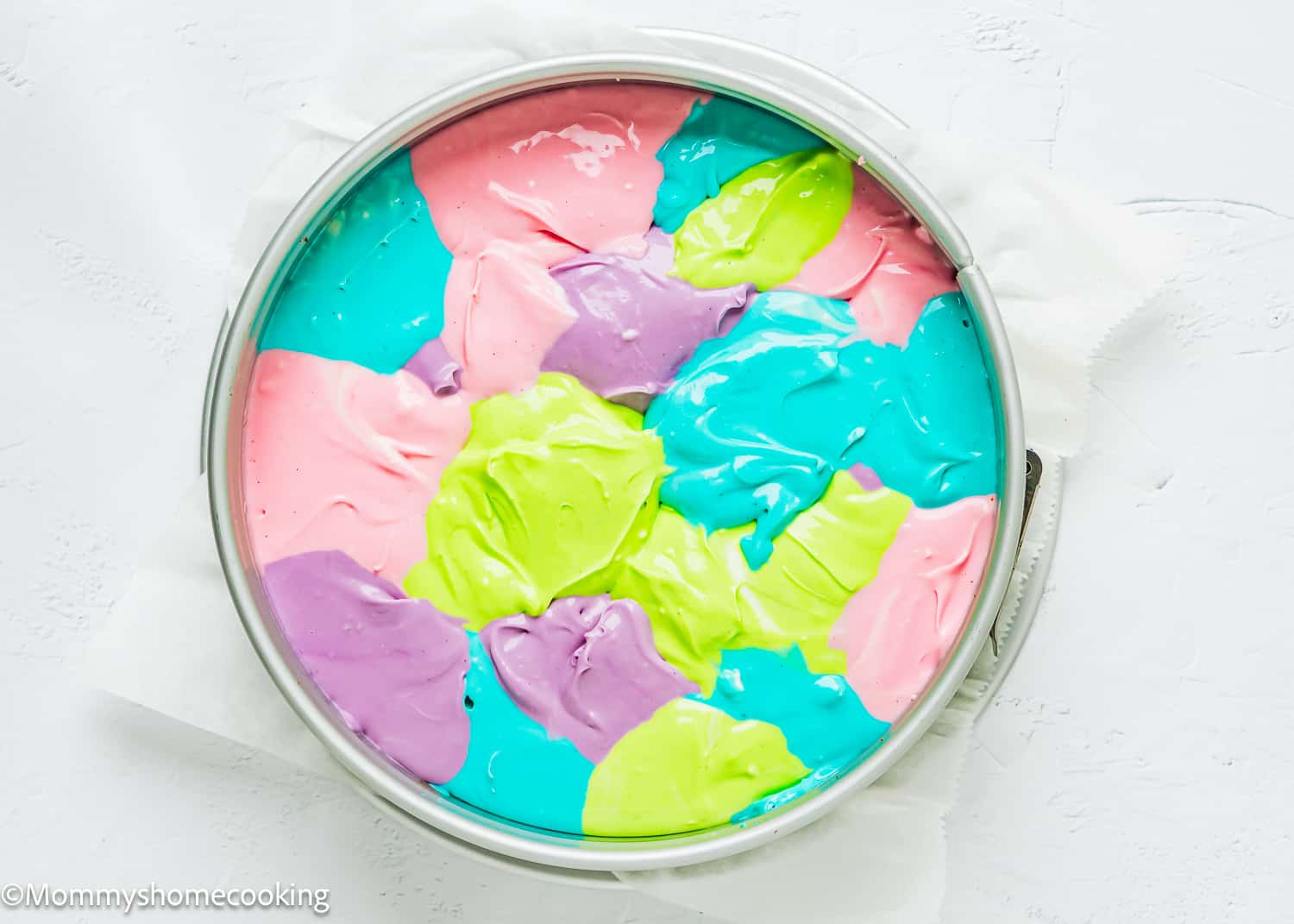
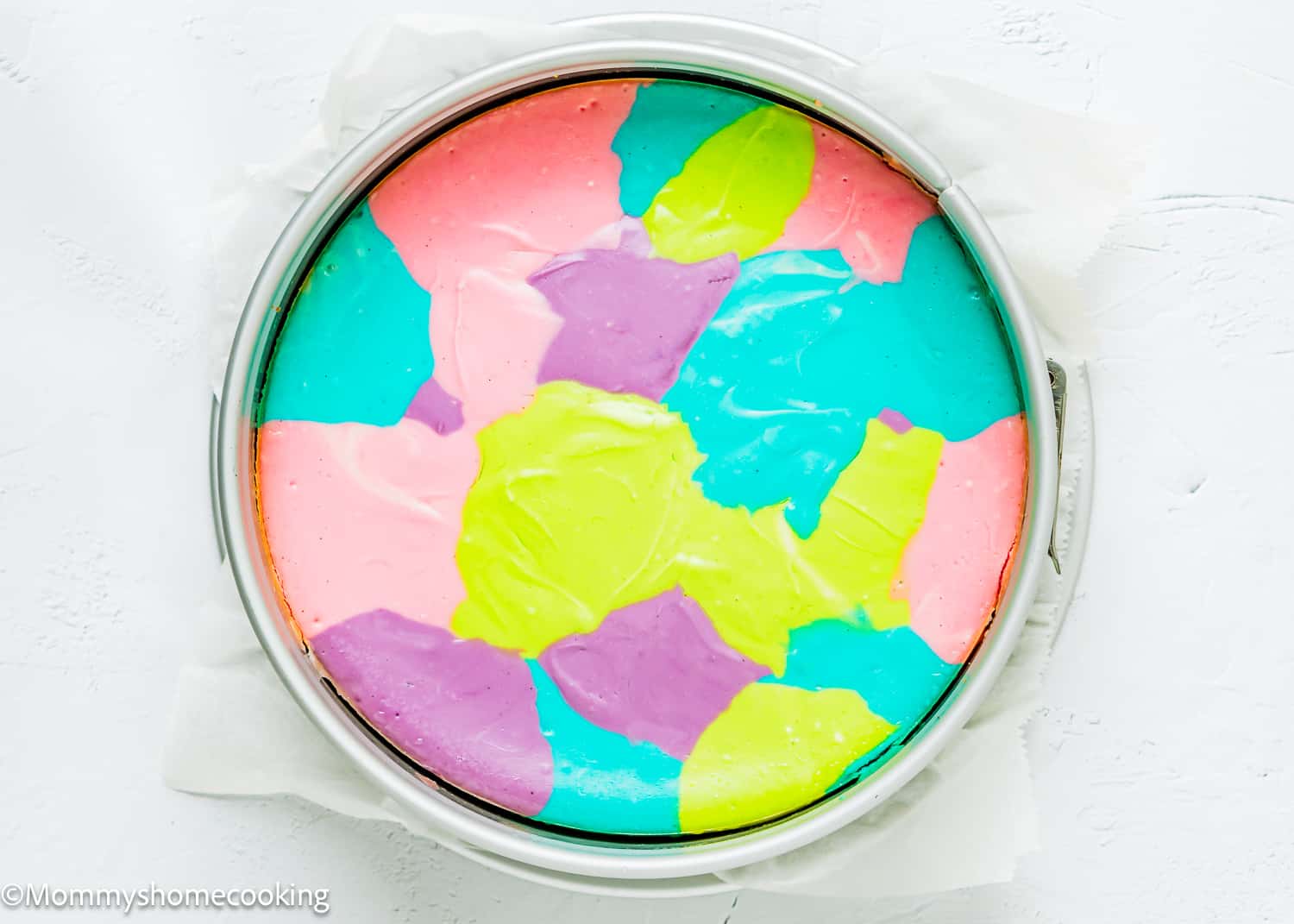
Loosen the cheesecake from the sides of the pan by running a thin metal spatula around the inside rim. Unmold and transfer to a cake plate. Decorate with whipped cream and sprinkles, if desired, and enjoy!
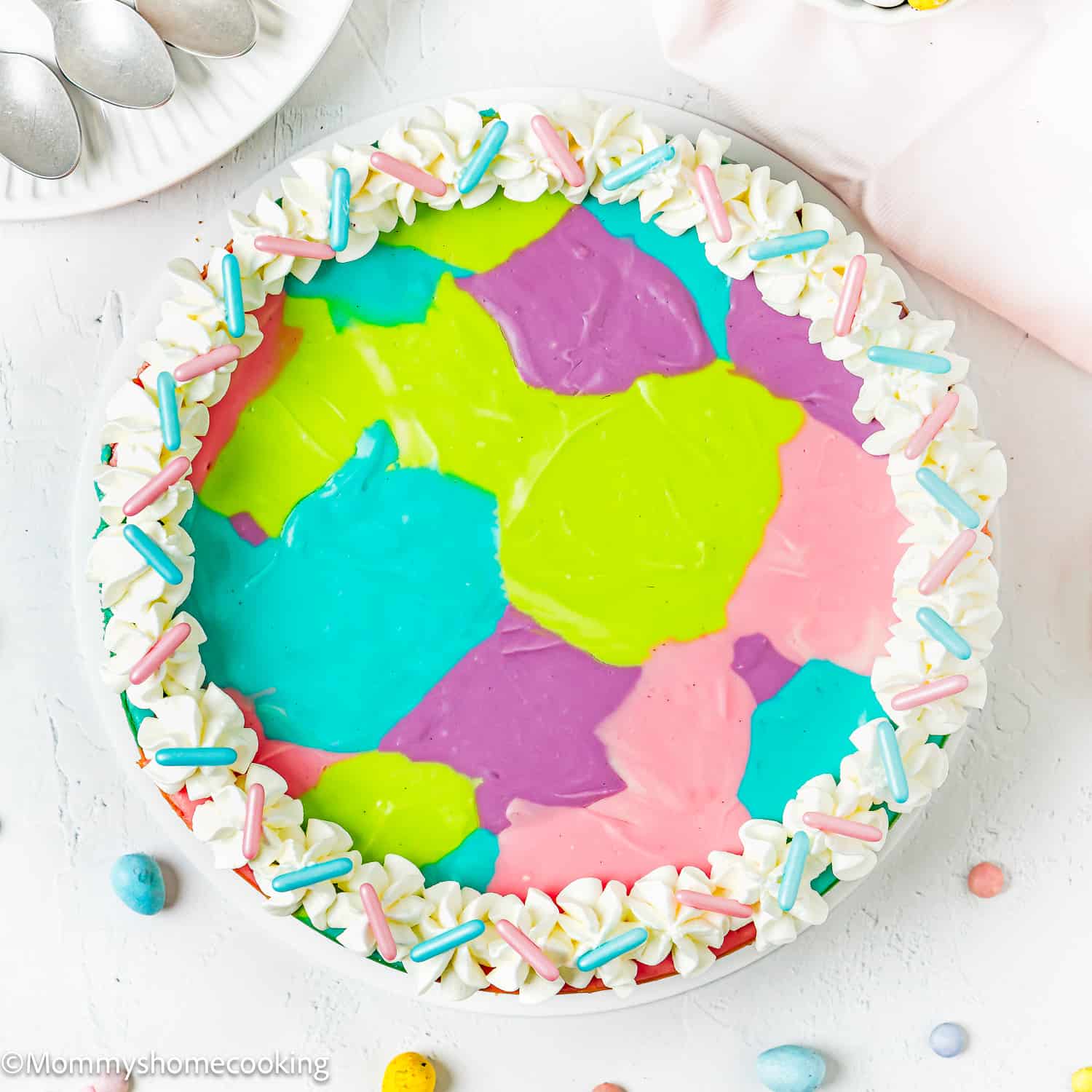
Recipe Tips
- Plan ahead! Cheesecake is one of those desserts that requires advance planning. It takes a long time to bake, chill, and set.
- Make sure all your ingredients are at room temperature. Also, measure the ingredients correctly. I highly recommend using a kitchen scale.
- Preheat the oven for at least 15 minutes before starting, giving it plenty of time to reach the ideal recipe temperature.
- Leaky pans are a cheesecake’s arch-nemesis. After many years of cheesecake making, I have concluded that most springform pans leak. To avoid water leaks, I like to wrap the springform pan with a double layer of heavy-duty foil and then a slow cooker liner. To do so, I place the springform pan in the middle of the slow cooker liner, grab all that excess baggage, wind it up, and tie the end with a knot, covering the underside and coming all the way to the top.
- Avoid overbaking the cheesecake, or it will crack in the center. When you remove it from the oven, the center should still wobble, and it will continue to cook as it cools on the counter.
- Ovens are all different, so baking times are always approximate. However, oven thermostats are sometimes inaccurate, which can affect baking time, so keep an eye on things. I highly recommend placing an oven thermometer inside the oven to make sure it’s heating properly.
- Allow the cheesecake to chill for at least 6 – 8 hours in the refrigerator before attempting to cut.
- Do you want to cut the perfect cheesecake slice? Use a thin knife that has been dipped in hot water and then wipe dry. Repeat this step before every single cut.
Food Allergy Swaps
- Dairy-free: You can use dairy-free or vegan alternatives for a dairy-free version. You’ll need cream butter (for the crust), cream cheese, sour cream, heavy cream, and sweetened condensed milk substitutes. Keep in mind that the texture and flavor may vary slightly. Check out my favorite dairy-free substitutes here.
- Gluten-free: Use your favorite gluten-free graham crackers or cookie crumbs for the crust. I like Pamela’s gluten-free Graham Crackers, but they contain milk. Kinnikinnick S’moreables, Graham Style Cracker is another milk and wheat-free alternative, but the label warms that it may contain eggs. Homefree Mini Ginger Snap Cookies are free of the 14 most common food allergens. So, if you are dealing with several allergies, make sure you find a safe alternative.

Variations & Additions
- Feel free to customize the flavors of this cheesecake by adding extracts or baking emulsions, such as lemon, almond, or coconut, for a unique twist.
- Experiment with different food color combinations to create your own custom look for your Easter cheesecake masterpiece.
Storing and Freezing Instructions
Store: You can store your Eggless Cheesecake covered and in the refrigerator for up to five days.
Freeze: Eggless Cheesecake can be frozen for up to three months.
- First, cool the cheesecake on the counter before freezing—you can skip cooling it in the refrigerator.
- Next, remove the outer rim of the springform pan (leave the base).
- Then wrap the cheesecake and the bottom of the pan with a few plastic wrap layers, then a final layer of aluminum foil. Don’t freeze your cheesecake with any toppings!
When you’re ready to eat your cheesecake, thaw it overnight in the refrigerator.
Frequently Asked Questions
Gel food colors are preferred for this recipe as they are more concentrated and won’t affect the consistency of the filling. Regular food coloring can be used, but you may need to adjust the amount to achieve your desired color intensity.
Absolutely! This cheesecake is perfect for making ahead. Prepare and bake the cheesecake as directed, then store it in the refrigerator until ready to serve. Allow it to come to room temperature before slicing and serving.
While you can certainly use low-fat cream cheese and sour cream, keep in mind that it may affect the texture and richness of the cheesecake. For the best results, I recommend sticking with full-fat ingredients for a creamy and indulgent dessert experience.
While it may seem like an extra step, using a water bath is well worth the effort for a cheesecake that looks as good as it tastes. The water bath helps ensure that the cheesecake bakes evenly without any hot spots, prevents the surface from drying out too quickly, and reduces the likelihood of unsightly cracks. And help the filling set gradually, resulting in a smooth and creamy consistency throughout. So, while baking your cheesecake in a water bath isn’t an absolute requirement, it’s highly recommended for achieving the best results.
If you’re worried about water leaking into the pan, you can try this alternate water bath method for making cheesecake. First, add 2 inches (5 cm) of boiling water into a large roasting pan; make sure the roasting pan has enough water. Then, place the cheesecake on the center oven rack of the preheated oven. Next, carefully place the roasting pan with the boiling water on the bottom rack. Immediately close the oven to trap the steam inside. This unique water bath technique adds steam to the oven without having the cheesecake sit inside the water itself. You don’t have to wrap the springform pan in foil using this method.
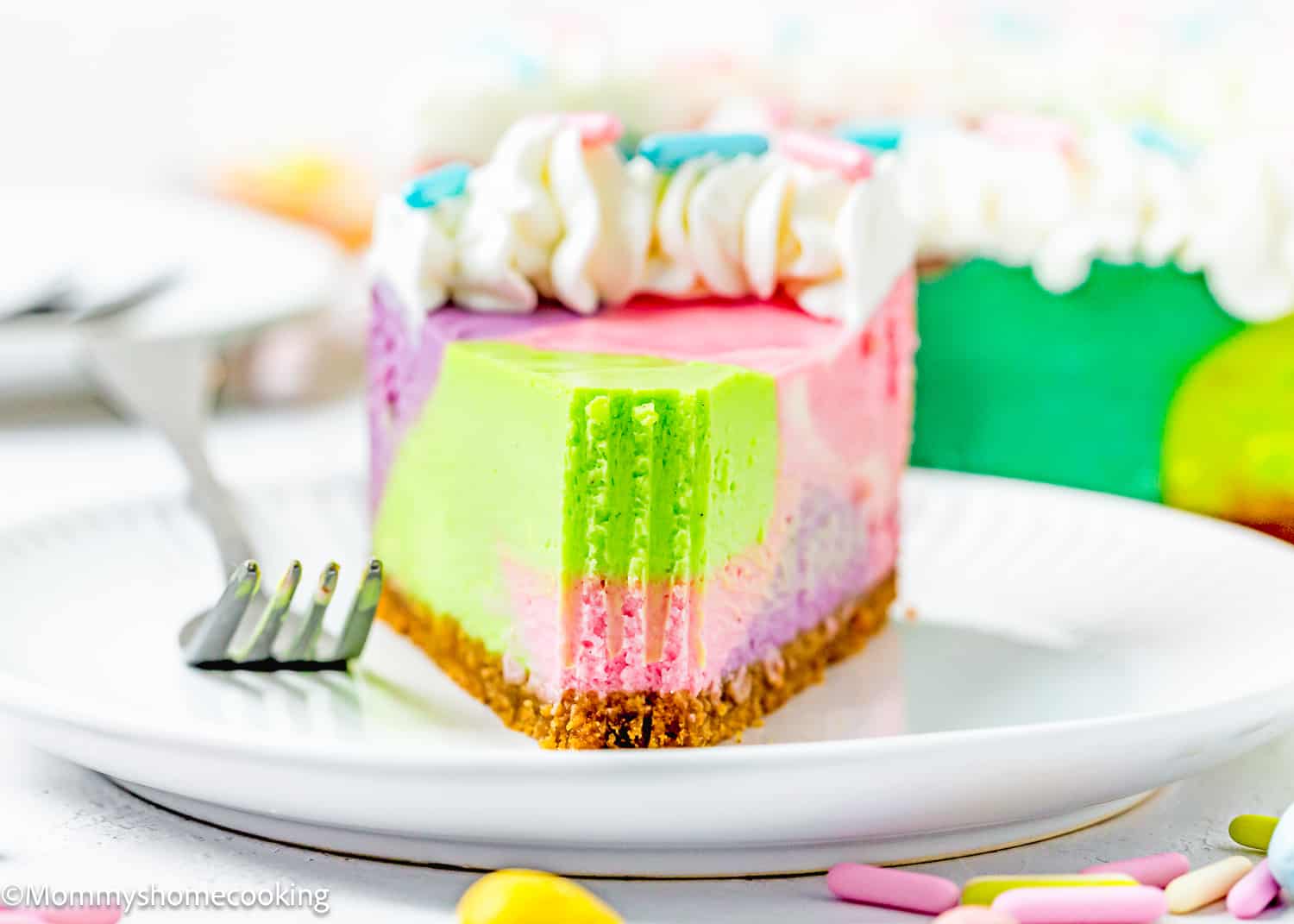
More Easter Recipes You’ll Love!
- Eggless Easter Hot Cross Buns
- Eggless Sugar Cookie Cake
- No-Bake Easter Cheesecake
- Eggless Easter Oatmeal Sandwich Cookies
- Easy Carrot Cake Snack Cake (No Eggs – No Dairy)
- Browse more recipes…
❤️ Love what you see? JOIN my Private Baking Club. Also, SUBSCRIBE to Mommy’s Home Cooking, so you’ll never miss a recipe! And FOLLOW along on Instagram, Pinterest, and Facebook for more fun!
Recipe Card 📖
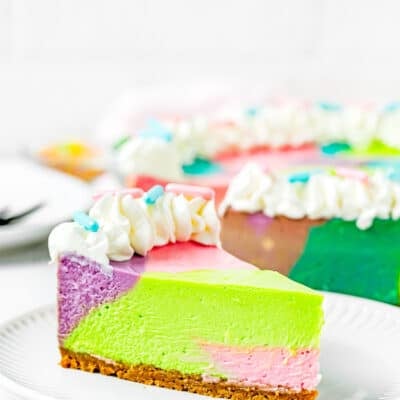
Easy Baked Easter Cheesecake (No Eggs)
Equipment
Ingredients
For the Crust:
- 1 ¾ cups (150 g) graham cracker crumbs (about 27 square sheets graham cracker)
- 1/4 cup (58 g) unsalted butter, melted
- 2 tablespoons (24 g) granulated sugar
For the Filling:
- 4 tablespoons (40 g) cornstarch
- 1/2 cup + 3 tablespoons (136 g) granulated sugar
- 32 oz (907 g) full fat cream cheese, softened (4 pkg 8oz. each)
- 2/3 cup (160 g) sour cream
- 19 oz (530 g) sweetened condensed milk
- 3 tablespoon (30 ml) lemon juice
- 3 teaspoons (15 ml) pure vanilla extract
- 2/3 cup (160 ml) heavy cream
- 4 gel food colors of your preference (I used pink, green, purple and blue)
Instructions
- Preheat oven to 350º F (180º C).
Prepare the Crust:
- Line the bottom and sides of a 9-inch round springform pan with parchment paper and lightly grease with baking spray.
- In a medium mixing bowl, combine graham crumbs, butter, and sugar with a fork until evenly moistened.
- Pour the crumbs mixture into the springform pan and press the crumbs down into the base (and up the sides if desired). Tip: Use the bottom of a measuring cup or glass to press down the crumbs evenly.
- Bake crust at 350º F (180º C) until set and fragrant, about 8 to 10 minutes. Remove to a wire rack to cool for at least 30 minutes before filling. Note: If you are short on time, you can refrigerate the unbaked crust until you make the filling. I have done it both ways, and it works fine. Baking the crust ensures a crispier bottom, though.
Prepare the Filling:
- Mix cornstarch and sugar in a small bowl. Set aside.
- Place the cream cheese and sour cream in the bowl of an electric mixer, beat on low speed for 2-3 minutes until smooth and free of any lumps. Add sugar mixture and continue mixing until incorporated. Gradually add sweetened condensed milk and beat until creamy, for 1-2 minutes. Add lemon juice and vanilla extract; beat until well incorporated. Add whipped heavy cream and increase the speed to medium, beat for 3 – 4 minutes. Set aside.
Prepare the Pan:
- Place the cheesecake pan on two large pieces of heavy-duty aluminum foil and fold up the sides around it (this is to keep the water from seeping into the cheesecake).Tip: Leaky pans are a cheesecake’s arch-nemesis. After many years of cheesecake making, I have concluded that most springform pans leak, so to avoid water leaks, I like to wrap the springform pan with a double layer of heavy-duty foil and then a slow cooker liner. To do so, I place the springform pan in the middle of the slow cooker liner, grab all that excess baggage, wind it up, and tie the end with a knot, covering the underside and coming all the way to the top.
Divide and Color the Batter:
- Divide the batter into 4 equal portions, about 2 cups (480 g) of batter each.
- Color each portion with the gel food colors of your preference. I used, pink, green, purple and blue.
- Add spoonfuls of colored batter to the baking pan. I used a ¼ cup ice cream spoon. To get a colorful pattern, don’t put the same colors too close together; instead, alternate the colors throughout the pan.
- When all the batter is in the pan; gently tap 3 – 4 times to remove any air bubbles and bring the portions together.
Water Bath:
- Place the cheesecake into a large roasting pan and carefully pour boiling water in (avoiding the cheesecake, of course) until it’s about halfway up the sides of the cheesecake pan.
Bake:
- Bake at 350º F (180º C) for 40 minutes or until the edges are just barely puffed, but the filling is pale—you're not looking for golden brown.
- Turn off the oven and leave the door closed for 40 more minutes (leave the cheesecake inside of the oven). The cheesecake will continue to cook, but slowly begin to cool as well.
- After 40 minutes, remove the cheesecake from the oven. The cheesecake center should still wobble when you remove it; it will continue to cook as it cools on the counter. Next, remove the cheesecake from the water bath and wrapping. Let it cool at room temperature. Then refrigerate for at least 6 – 8 hours, or overnight (better).
- Loosen the cheesecake from the sides of the pan by running a thin metal spatula around the inside rim. Unmold and transfer to a cake plate. Decorate with whipped cream and sprinkles, if desired, and enjoy!
- First, cool the cheesecake on the counter before freezing—you can skip cooling it in the refrigerator.
- Next, remove the outer rim of the springform pan (leave the base).
- Then, wrap the cheesecake and the bottom of the pan with a few layers of plastic wrap and a final layer of aluminum foil. Don’t freeze your cheesecake with any toppings!
- Plan ahead! Cheesecake is one of those desserts that requires advance planning. It takes a long time to bake, chill, and set.
- Make sure all your ingredients are at room temperature. Also, measure the ingredients correctly. I highly recommend using a kitchen scale.
- Preheat the oven for at least 15 minutes before starting, giving it plenty of time to reach the ideal recipe temperature.
- Leaky pans are a cheesecake’s arch-nemesis. After many years of cheesecake making, I have concluded that most springform pans leak. To avoid water leaks, I like to wrap the springform pan with a double layer of heavy-duty foil and then a slow cooker liner. To do so, I place the springform pan in the middle of the slow cooker liner, grab all that excess baggage, wind it up, and tie the end with a knot, covering the underside and coming all the way to the top.
- Avoid overbaking the cheesecake, or it will crack in the center. When you remove it from the oven, the center should still wobble, and it will continue to cook as it cools on the counter.
- Ovens are all different, so baking times are always approximate. However, oven thermostats are sometimes inaccurate, which can affect baking time, so keep an eye on things.
- Allow the cheesecake to chill for at least 6 – 8 hours in the refrigerator before attempting to cut.
- Do you want to cut the perfect cheesecake slice? Use a thin knife that has been dipped in hot water and then wipe dry. Repeat this step before every single cut.
- Dairy-free: You can use dairy-free or vegan alternatives for a dairy-free version. You’ll need cream butter (for the crust), cream cheese, sour cream, heavy cream, and sweetened condensed milk substitutes. Keep in mind that the texture and flavor may vary slightly. Check out my favorite dairy-free substitutes here.
- Gluten-free: Use your favorite gluten-free graham crackers or cookie crumbs for the crust. I like Pamela’s gluten-free Graham Crackers, but they contain milk. Kinnikinnick S’moreables, Graham Style Cracker is another milk and wheat-free alternative, but the label warms that it may contain eggs. Homefree Mini Ginger Snap Cookies are free of the 14 most common food allergens. So, if you are dealing with several allergies, make sure you find a safe alternative.
- Feel free to customize the flavors of this cheesecake by adding extracts or baking emulsions, such as lemon, almond, or coconut, for a unique twist.
- Experiment with different food color combinations to create your own custom look for your Easter cheesecake masterpiece.

Leave a Reply